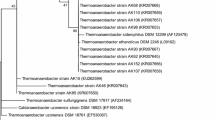Abstract
The metabolic pattern of utilization of [1,2,3,4-14C, methyl-3H] γ-butyrobetaine and d-and l-[1-14C, methyl-3H]carnitine has been examined with variously grown resting cell suspensions of Acinetobacter calcoaceticus and Pseudomonas putida. Ps. putida grown on d, l-carnitine as the sole source of carbon, degraded only l-carnitine with stoichiometric accumulation of glycinebetaine. Alternatively, when grown on γ-butyrobetaine, Ps. putida rapidly metabolized γ-butyrobetaine, and to a lesser but significant extent, both d-and l-carnitine with equivalent formation of trimethylamine and degradation of the betaine carbon skeleton. Ac. calcoaceticus grown on either d,l-carnitine or γ-butyrobetaine, effectively utilized all three betaines at nearly the same rates. Disappearance of each of these quarternary ammonium compounds was accompanied by stoichiometric formation of trimethylamine and degradation of the carbon backbone. Utilization of the betaines and corresponding formation of trimethylamine by resting cell suspensions of appropriately grown Ac. calcoaceticus and Ps. putida, was essentially abolished under conditions of anaerobiosis and severely impaired in the presence of sodium cyanide, sodium azide, 2,4-dinitrophenol or 2,2′-bipyridine. The results of the present investigations with resting cell suspensions of both Ac. calcoaceticus and Ps. putida do not support an earlier suggestion that γ-butyrobetaine degradation in these organisms proceeds by its prior hydroxylation to l-carnitine. Indeed, disrupted cell-free preparations of Ac. calcoaceticus and Ps. putida grown on either d,l-carnitine or γ-butyrobetaine showed no detectable γ-butyrobetaine hydroxylase activity.
Similar content being viewed by others
References
Abbott MT, Udenfriend S (1974) α-Ketoglutarate-coupled dioxygenases. In: Hayaishi O (ed) Molecular mechanisms of oxygen activation. Academic Press, New York, pp. 167–214
Aurich H, Kleber, H-P, Schöpp W-D (1967) An inducible carnitine dehydrogenase from Pseudomonas aeruginosa. Biochim Biophys Acta 139:505–507
Aurich H, Kleber H-P, Sorger H, Tauchert H (1968) Reinigung und Eigenschaften der Carnitindehydrogenase aus Pseudomonas aeruginosa. Eur J Biochem 6:196–201
Aurich H, Rotzsch W, Strack E (1963) Assimilation von (-)-Carnitine durch Pseudomonas ovalis. Acta Biol Med Germ 11:274–280
Blanchard JS, Englard S, Kondo A (1982) γ-Butyrobetaine hydroxylase: a unique protective effect of catalase. Arch Biochem Biophys (in press)
Cox RA, Hoppel CL (1973) Biosynthesis of carnitine and 4-N-trimethylaminobutyrate from lysine. Biochem J 136:1075–1082
Dunn WA, Englard S, (1981) Carnitine biosynthesis by the perfused rat liver from exogenous protein-bound trimethyllysine. J Biol Chem 256:12437–12444
Eneroth P, Lindstedt G (1965), Thin-layer chromatography of betaines and other compounds related to carnitine. Anal Biochem 10:479–485
Englard S, Horwitz LJ, Tugendhaft-Mills J (1978) A simplified method for the measurement of γ-butyrobetaine hydroxylase activity. J Lipid Res 19:1057–1063
Hayaishi O, Nozaki M, Abbott MT (1975) Oxygenases: dioxygenases. In: Boyer PD (ed) The enzymes, vol XII 3rd edition. Academic Press, New York, pp 119–189
Kaufman RA, Broquist HP (1977) Biosynthesis of carnitine in Neurospora crassa. J Biol Chem 252:7437–7439
Kelly B, Appleman MD (1961) Degradation of ergothioneine by cell-free extracts of Alcaligenes faecalis. J Bacteriol 81:715–720
Kleber H-P, Aurich H (1967) Evidence for an inducible active transport of carnitine in Pseudomonas aeruginosa. Biochem Biophys Res Commun 26:255–260
Kleber H-P, Schöpp, W, Aurich H (1973) Verwertung von n-Alkanen durch einen Stamm von Acinetobacter calcoaceticus. Z Allg Mikrobiol 13:445–447
Kleber H-P, Seim H, Aurich H, Strack E (1977) Verwertung von Trimethylammoniumverbindungen durch Acinetobacter calcoaceticus. Arch Microbiol 112:201–206
Kleber H-P, Schöpp W, Aurich H (1973) Verwertung von n-Alkanen durch einen Stamm von Acinetobacter calcoaceticus. Z Allg Mikrobiol 13:445–447
Kleber H-P, Seim H, Aurich H, Strack E (1977) Verwertung von Trimethylammoniumverbindungen durch Acinetobacter calcoaceticus. Arch Microbiol 112:201–206
Kleber H-P, Seim H, Aurich H, Strack E (1978) Beziehung zwischen Carnitinstoffwechsel und Fettsäureassimilation bei Pseudomonas putida. Arch Microbiol 116:213–220
Kondo A, Blanchard JS, Englard S (1981) Purification and properties of calf liver γ-butyrobetaine hydroxylase. Arch Biochem Biophys 212:338–346
Lindstedt G, Lindstedt S (1970) Cofactor requirements of γ-butyrobetaine hydroxylase from rat liver. J Biol Chem 245:4178–4186
Lindstedt G, Lindstedt S, Midtvedt T, Tofft M (1967) The formation and degradation of carnitine in Pseudomonas. Biochemistry 6:1262–1270
Lindstedt G, Lindstedt S, Nordin I (1977) Purification and properties of γ-butyrobetaine hydroxylase from Pseudomonas sp. AK1. Biochemistry 16:2181–2188
Lindstedt G, Lindstedt S, Tofft M (1970) γ-Butyrobetaine hydroxylase from Pseudomonas sp. AK1. Biochemistry 9:4336–4342
McGarry JD, Foster DW (1976) An improved and simplified radiosisotopic assay for the determination of free and esterified carnitine. J Lipd Res 17:277–281
Miura J, Englard S (1982) Utilization of γ-butyrobetaine and d-and l-carnitine by Acinetobacter calcoaceticus and Pseudomonas putida. Federation Proc 41:1166
Seim H, Löster H, Claus R, Kleber H-P, Strack E (1982) Splitting of the C-N bond in carnitine by an enzyme (trimethylamine forming) from membranes of Acinetobacter calcoaceticus. FEMS Microbiol Lett 15:165–167
Strack E, Aurich H, Gruner E (1964) Über die Abbaufähigkeit bestimmter Pseudomonas-Species für (-)-Carnitin. Z Allg Mikrobiol 4:154–160
Strack E, Noack R, Aurich H, Focke G, Lorenz I (1962) Untersuchungen über den Abbau von Carnitin durch Pseudomonas pyocyanea A 7244. Acta Biol Med Germ 9:115–125
Wall JS, Christianson DD, Dimler RJ, Senti FR (1960) Spectrophotometric determination of betaines and other quaternary nitrogen compounds as their periodides. Anal Chem 32:870–874
Wolff JB (1962) Ergothionase from Escherichia coli J Biol Chem 237:874–881
Yanasugondha D, Appleman MD (1957) Degradation of ergothioneine by Alcaligenes faecalis. J Bacteriol 74:381–385
Author information
Authors and Affiliations
Rights and permissions
About this article
Cite this article
Miura-Fraboni, J., Kleber, HP. & Englard, S. Assimilation of γ-butyrobetaine, and d-and l-carnitine by resting cell suspensions of Acinetobacter calcoaceticus and Pseudomonas putida . Arch. Microbiol. 133, 217–221 (1982). https://doi.org/10.1007/BF00415004
Received:
Accepted:
Issue Date:
DOI: https://doi.org/10.1007/BF00415004




